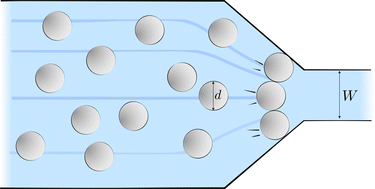Influence of the solid fraction on the clogging by bridging of suspensions in constricted channels†
Abstract
Clogging can occur whenever a suspension of particles flows through a confined system. The formation of clogs is often correlated to a reduction in the cross-section of the channel. In this study, we consider the clogging by bridging, i.e., through the formation of a stable arch of particles at a constriction that hinders the transport of particles downstream of the clog. To characterize the role of the volume fraction of the suspension on the clogging dynamics, we study the flow of particulate suspensions through 3D-printed millifluidic devices. We systematically characterize the bridging of non-Brownian particles in a quasi-bidimensional system in which we directly visualize and track the particles as they flow and form arches at a constriction. We report the conditions for clogging by bridging when varying the constriction width to particle diameter ratio for different concentrations of the particles in suspension. We then discuss our results using a stochastic model to rationalize the influence of solid fraction on the probability of clogging. Understanding the mechanisms and conditions of clog formation is an important step for optimizing engineering design and developing more reliable dispensing systems.



 Please wait while we load your content...
Please wait while we load your content...